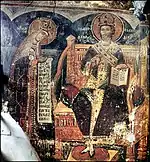Church of St. Athanasius of Mouzaki
St. Athanasius of Mouzaki (Greek: Άγιος Αθανάσιος του Μουζάκη) (Albanian: Shën Athansi i Muzakajve) is a Greek Orthodox church located in Kastoria, Greece.[1][2] It was built in 1383–84 by the brothers Theodore II and Stoya of the house of Muzaka, a noble Albanian family that controlled the city at the time, and dedicated to St. Athanasius[1][2] It is considered one of the most important monuments of 14th century Kastoria and is the last church built in Kastoria before its annexation by the Ottoman Empire.[2]
| Church of Saint Athanasius of Mouzaki | |
|---|---|
Ναός του Αγίου Αθανασίου του Μουζάκη (in Greek) | |
 Church of St. Athanasius of Mouzaki in 2010 | |
| Religion | |
| Affiliation | Eastern Orthodox |
| Leadership | Greek Orthodox Church |
| Location | |
| Location | Kastoria, Greece |
| Geographic coordinates | 40.5152°N 21.2672°E |
| Architecture | |
| Type | Church |
| Style | Byzantine architecture |
| Founder | Theodore II Muzaka and Stoya Muzaka |
| Completed | 1384 |
Decorations

The church is decorated with scenes of saints dressed in Byzantine clothing, a typical feature of Byzantine iconography. The frescoes are remarkable for depicting for the first time in Byzantine iconography, Jesus Christ and the Virgin Mary in imperial costume.[3] The depiction of Virgin Mary as a queen is an atypical feature for the Byzantine iconography.[4] Another unusual feature of the church is that, despite the fact that St. Alexander is traditionally not included among the ranks of military saints,[5] the church of St Athanasius of Mouzaki is decorated with a portrait of St. Alexander in military clothing.
Legacy
The church influenced greatly the artistic production of Kastoria and the region of Macedonia in the late 14th and early 15th century.[6]
Sources
| Wikimedia Commons has media related to Saint Athanasius of Mouzakis Church. |
- Facaros, Dana; Theodorou, Linda (2003). Greece. New Holland Publishers. p. 563. ISBN 1-86011-898-4.
- "St Athanasius of Mouzakis" (in Greek). Kastoria City. Retrieved 12 July 2010.
- Herrin, Judith (2013). Unrivalled Influence: Women and Empire in Byzantium. Princeton University Press. p. 172. ISBN 9780691153216.
The first time Christ and the Virgin appear in imperial costume occurs only outside the empire in Kastoria and on the eve of the Ottoman conquest in 1384-85.
- Vassilaki, Maria (2000). Mother of God: representations of the Virgin in Byzantine art. Skira. p. 129. ISBN 88-8118-738-8.
- Walter, Christopher (2003). The warrior saints in Byzantine art and tradition. Ashgate Publishing, Ltd. p. 245. ISBN 1-84014-694-X.
- Myrtalē Acheimastou-Potamianou, ed. (1988). Holy image, holy space: icons and frescoes from Greece. Greek Ministry of Culture. p. 194.